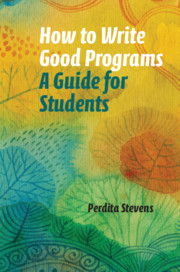Book contents
- Frontmatter
- Contents
- 1 Introduction
- 2 What Are Good Programs?
- 3 How to Get Started
- 4 How to Understand Your Language
- 5 How to Use the Best Tools
- 6 How to Make Sure You Don’t Lose Your Program
- 7 How to Test Your Program
- 8 How to Make Your Program Clear
- 9 How to Debug Your Program
- 10 How to Improve Your Program
- 11 How to Get Help (without Cheating)
- 12 How to Score Well in Coursework
- 13 How to Score Well in a Programming Exam
- 14 How to Choose a Programming Language
- 15 How to Go Beyond This Book
- Bibliography
- Index
4 - How to Understand Your Language
Published online by Cambridge University Press: 10 July 2020
- Frontmatter
- Contents
- 1 Introduction
- 2 What Are Good Programs?
- 3 How to Get Started
- 4 How to Understand Your Language
- 5 How to Use the Best Tools
- 6 How to Make Sure You Don’t Lose Your Program
- 7 How to Test Your Program
- 8 How to Make Your Program Clear
- 9 How to Debug Your Program
- 10 How to Improve Your Program
- 11 How to Get Help (without Cheating)
- 12 How to Score Well in Coursework
- 13 How to Score Well in a Programming Exam
- 14 How to Choose a Programming Language
- 15 How to Go Beyond This Book
- Bibliography
- Index
Summary
This chapter discusses the most fundamental aspects of programming language theory, to help you situate the language you are learning in the landscape of all programming languages. It covers compilation versus interpretation, different approaches to type systems, structuring mechanisms, and the importance of finding a reputable body of code in your language to use as a model.
- Type
- Chapter
- Information
- How to Write Good ProgramsA Guide for Students, pp. 33 - 47Publisher: Cambridge University PressPrint publication year: 2020

